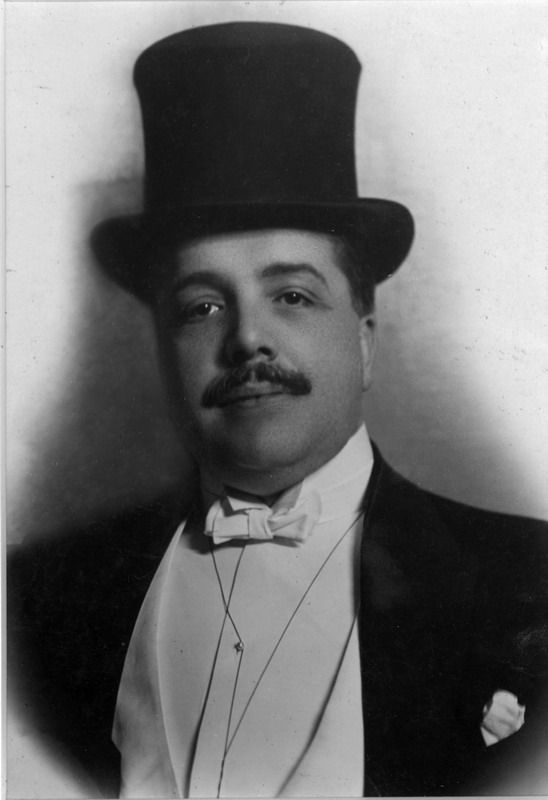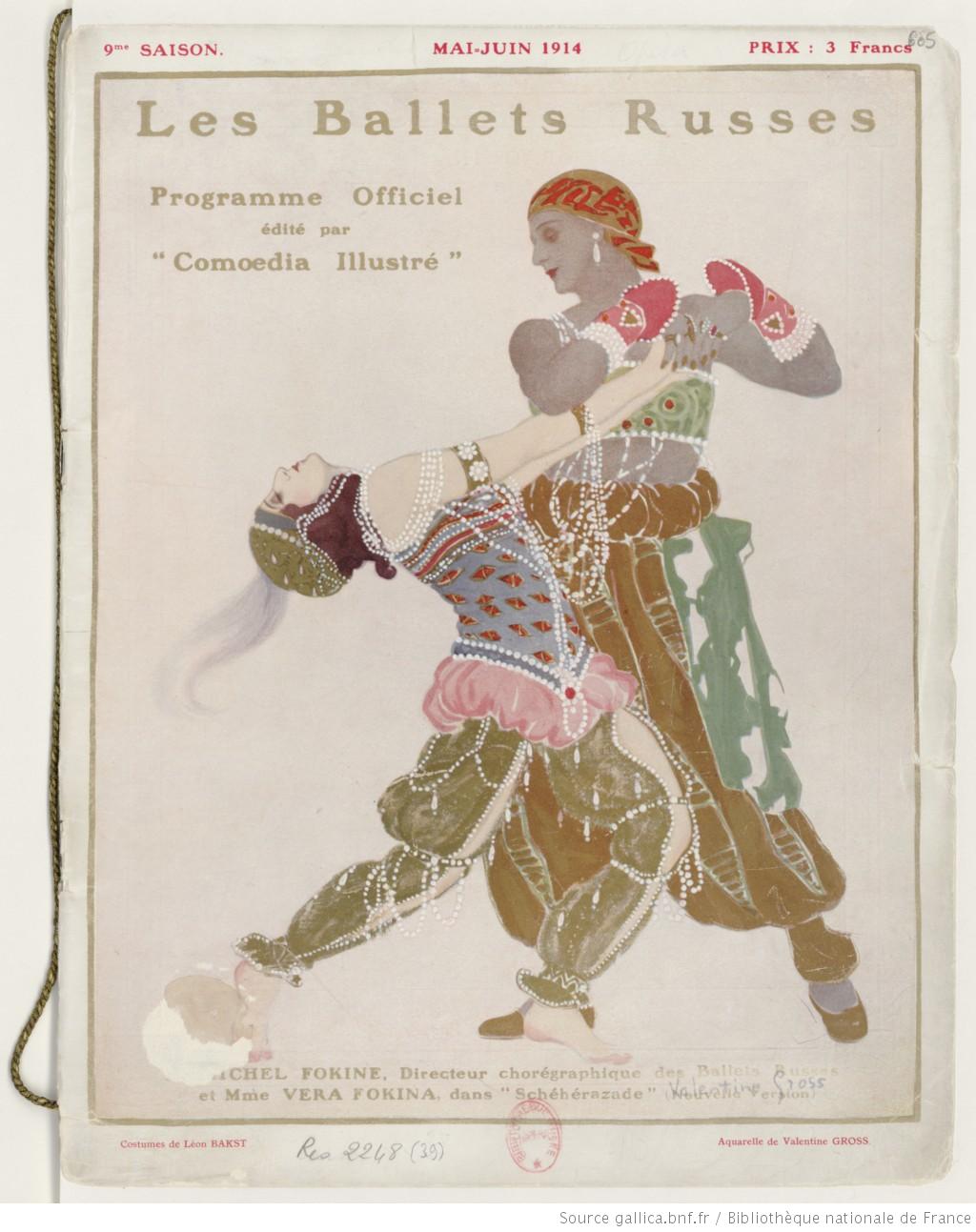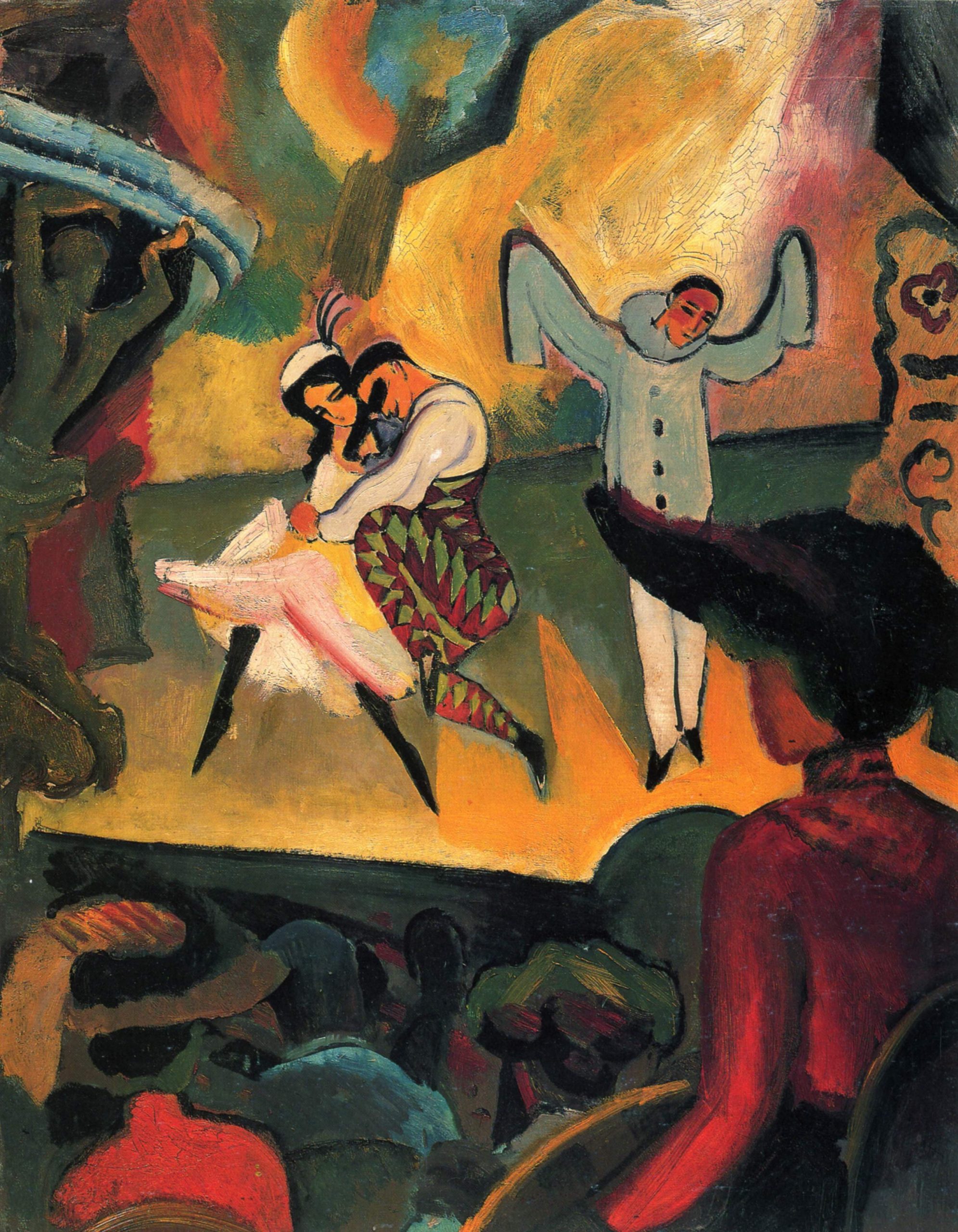Alexandra Banister, Kate Stephenson, The Art Story

Diaghilev was praised by his contemporaries as a key figure in bringing Russian art and music to the West. The fashion designer Coco Chanel who costumed Diaghilev’s ballet Le Train Bleu in 1924, stated that “Diaghilev invented Russia for foreigners”.
The legacy of Sergei Diaghilev
In his commissions from rising musical composers, Diaghilev helped shape the musical landscape of the 20th century. By championing such experimental composers as Stravinsky, Diaghilev aided the development of new tonality and rhythm, freeing up traditional concepts of ballet music. Without Diaghilev’s support, such composers would not have written some of the major musical masterpieces of that century. This brought music and ballet to a wider audience and reestablished the popularity of ballet as a major art form.
Diaghilev’s harsh but nurturing encouragement of young dancing talent and his willingness to allow dancers to also work as choreographers changed the face of modern dance. Tamara Karsavina, one of the Ballets Russes’ troupe, who later emigrated to London and was a founding member of the Royal Academy of Dance, noted that “many are the names which Diaghilev wrote, with his own hand, in the book of fame”. Many of the dancers and choreographers involved in the Ballets Russes went on to found important dance schools in North America, such as George Balanchine and Ruth Page, and in England, such as Marie Rambert and Ninette de Valois.
Similarly, his decision to commission avant-garde artists to create the Ballets Russes’ sets and costumes had huge repercussions across Europe. Diaghilev revealed to the West the importance of Russian art; both traditional and radical. The use of color and Eastern influences revolutionized the aesthetics of early 20th-century design, theater, and fashion. The modern Cubist costumes featured in productions such as Parade can be seen as a direct precursor to later experimental theater designs. Oskar Schlemmer’s teachings at the Bauhaus borrowed heavily from the geometric designs of Picasso as commissioned by Diaghilev.
The designs also had an impact on the Paris fashion houses and particularly on the work of designer Paul Poiret. In the wake of the Ballet Russes’ production of Scheherazade (1910), Poiret produced collections of clothing which espoused an opulent Orientalist aesthetic and included bright colors, sumptuous fabrics, and items such as turbans and harem pants. His work went on the influence both mainstream fashion and interior design. More recently, Yves Saint Laurent’s 1976 haute couture collection, belle Russe, paid homage the costumes of the Ballet Russes.
Diaghilev was also key in changing Russian cultural attitudes. This can be seen in the World of Art journal, which, although only surviving five years, informed readers about art of the Russian past and present. In doing so, it departed from the academic traditions or revolutionary beliefs of the prevailing critical landscape. As the Russian historian Simon Karlinsky describes, Diaghilev was a “cultural educator of genius”. Despite not being a creator himself, Diaghilev was the instigator of many of the major cross-cultural creative moments of the early 20th century.
Childhood
Diaghilev was born in Selishchev Barracks, a military community in the western Russian province of Novgorod. His father, Pavel Pavlovich, was a military officer, whose family had made their money from vodka distilleries. Following the death of his wife whilst his son was still an infant, Pavel married Elena Valerianovna Panaeva, an artistic woman and amateur singer. Elena introduced Diaghilev to the world of music and instructed his early education, encouraging in him a love of the arts. Throughout his life Diaghilev remained close to his stepmother, continuing to write to her until her death in 1919. The family moved from the military Barracks to Perm, and then to an apartment in St Petersburg in the 1880s.
Early life
In 1890, Diaghilev finished school and embarked on a tour of Western Europe, taking in the cultural sights and museums of cities such as Paris, Venice, and Rome, all of which he would return to later in life. Afterwards, Diaghilev moved to St Petersburg to study law, but also took classes at the St Petersburg Conservatory of Music in his spare time, hoping to become a composer. By 1892, however, he had abandoned this dream, as his professor Nikolai Rimsky-Korsakov, told him he had no talent for music.
Whilst at university, Diaghilev joined a circle of intellectual art-lovers who called themselves the Nevsky Pickwickians. Amongst the group were the artists Alexandre Benois and Léon Bakst, and the writers Dmitry Filosofov (who was also Diaghilev’s cousin) and Walter Nouvel.
The group were joined by their love of the arts and their frustration with how critics wrote about art at the time. There were two main types of criticism: a patriotic, traditionally academic genre versus a more revolutionary type of critic, who called for all art to be socially relevant. The Nevsky Pickwickians saw both of these approaches as limiting and instead drew attention to largely overlooked areas of art, such as Russian icons, church frescoes, Romantic painters of the previous centuries, and Western art such as the Pre-Raphaelites in England. It was this renewal of the Russian past, teamed with new discoveries in Western art, which informed Diaghilev’s ever-evolving tastes during the 1890s.
In 1898, the Nevsky Pickwickians founded a journal called Mir Iskusstva (World of Art), with financial backing from the arts patron Princess Maria Tenisheva and the merchant Savva Mamontov. From the moment the journal was published, critics on both the political left and right sought to discredit its ideas.
The traditionalist art critic Vladimir Stasov described the works featured in the journal, including those by Edgar Degas, Claude Monet, and Bakst, as “the work of a three-year-old child holding a pencil for the first time”. From the other side, the critic Viktor Burenin, writing in the revolutionary newspaper New Times, attacked Diaghilev personally: “the pretensions of a Mr. Diaghilev who edits this journal are not only astounding but also extraordinarily stupid”. The negative criticism did not stop Diaghilev and the World of Art movement. He continued to publish critical art pieces, and in 1897 organized an exhibition in St Petersburg showcasing the type of art the group championed.
By 1899, Diaghilev had secured a job working for Prince Sergei Mikhaylovich Volkonsky, the director of the Imperial Theaters. Diaghilev was responsible for the production of the Theaters’ annual showcase in 1900, a role which fully immersed him in the theatrical world for the first time. Following this, he was tasked with staging Léo Delibes’ ballet Sylvia. He chose his friend Alexandre Benois to work with on the design, but their ideas shocked the Theater. Refusing to change his artistic vision, Diaghilev was fired by Volkonsky shortly after.
Mature period

After this incident, Diaghilev returned to organizing art exhibitions and in 1905, he staged an exhibition of Russian painting at the Tauride Palace in St Petersburg. To prepare for this, Diaghilev travelled throughout Russia collecting Russian artists of the past and present and in doing so collated a huge number of works by fine art painters of the 19th century who had been largely ignored or forgotten. The next year, he expanded his ambitions and took an exhibition of Russian art, from icons to modernist works, to the Petit Palais in Paris, and subsequently toured the exhibition to Berlin and Venice.
Encouraged by the warm reception he had received for Russian art in Paris, Diaghilev returned to his love of music. In 1907 he staged five concerts of Russian music in Paris, with appearances by his former mentor Rimsky-Korsakov, as well as Rachmaninoff and Scriabin. The following year, he presented Mussorgsky’s Boris Godunov at the Paris Opéra which garnered glowing reviews.
Bolstered by the success of his productions in Paris, Diaghilev founded the Ballets Russes in 1909. He appointed Mikhail Fokine as chief choreographer, who, despite his traditional training at the Imperial Ballet School in St Petersburg, was an avant-gardist who sought to blend ballet with modern dance.
The young Vaslav Nijinsky, who was also Imperial Ballet School trained, was cast as the company’s prime male dancer. Diaghilev’s World of Art companion Léon Bakst took the role of artistic director and he designed many of the costumes. Both he and Daighilev shared the aim of creating a total work of art (a concept known as Gesamtkunstwerk) through the seamless combination of performance, music and set, and costume design. Given the enthusiasm for Russian art and music shown by French audiences, Bakst and Diaghilev added an unapologetically Russian style to the Ballets Russes’ productions. The designs were visually stimulating, bringing in the color and exoticism of the Russian east combined with the Art Nouveau fashions of the West. This dynamic and innovative approach resulted in an opening night sensation. The French writer Jean Cocteau said the performances “shook France”.
The Ballets Russes quickly became in demand across Europe and Diaghilev established them as a year-round touring operation in 1911. The success enjoyed during this period was seen by Diaghilev and Bakst as a long-awaited justification of the World of Art group’s ideas of the 1890s. As the driving force behind the company, Diaghilev became inextricably linked with it. He quickly developed a reputation as a hard taskmaster, demanding only the best from his dancers and inspiring fear and respect in those who worked for the company. The composer Erik Satie described Diaghilev as “an amiable sort, but an awful person”.
As the company went from strength to strength, Diaghilev commissioned ballet music from composers including Claude Debussy (Jeux, 1913), Maurice Ravel (Daphnis et Chloé, 1912), Richard Strauss (Josephslegende, 1914), and Erik Satie (Parade, 1917). His most notable collaborator, however, was the relatively unknown Russian composer Igor Stravinsky. At the age of 28, Stravinsky had previously composed music for Diaghilev and had impressed him with his ability to deliver scores at short notice. Diaghilev commissioned a full score for The Firebird, which, following its première at the Paris Opéra in June 1910, was met with immediate acclaim. Following this success, Diaghilev was quick to commission more from Stravinsky, resulting in Petrushka in 1911 and The Rite of Spring in 1913. Diaghilev’s unfaltering support for talent from his homeland was also seen in his commissioning of up-and-coming Russian modernist artists. For example, from 1914, his principal set designers included the avant-garde artist Natalia Goncharova who, like the World of Art group, looked to older Russian art for new inspirations.
By 1912, Nijinsky was choreographing ballets for the company, including Debussy’s L’après-midi d’un faune and Stravinsky’s Le Sacre du Printemps. However, following Nijinsky’s sudden marriage to the Hungarian aristocrat Romola de Pulszky whilst on tour with the company in South America in 1913, the dancer was promptly dismissed by Diaghilev. This decision was certainly in part motivated by Diaghilev’s personal feelings for Nijinsky, but it was also common practice for dancers to leave the Ballets Russes when they got married. Nijinsky did appear again with the company in the 1920s, but his relationship with Diaghilev was never the same following his ‘betrayal’.
Following Nijinsky’s fall from grace, Diaghilev returned to Moscow to scout a replacement for his role in the upcoming performance of Strauss’s Josephslegende. Diaghilev chose the nineteen-year-old Léonide Massine, a recent graduate from the Moscow Imperial Theater School. Like Nijinsky, Massine was soon starring in the main male roles for the Ballets Russes and went on to choreograph many of their major post-war productions.
Late period

The First World War meant the Ballets Russes had to adapt quickly to very different circumstances. Economic hardship spread across Europe and pastimes such as going to the ballet were deemed by many as frivolous and luxurious. Diaghilev faced the challenge of depleted audiences with flexibility, taking the company on a tour of North America for several years from 1915.
The events of 1917 proved even trickier for Diaghilev and his contemporaries to react to. The Russian revolution in February 1917 was initially welcomed by the World of Art group, signaling a new and free society and the fresh approach to art that they had long advocated. To celebrate, Diaghilev had dancers carry a red flag in the finale of that year’s production of The Firebird. However, the subsequent revolution of October 1917 and resulting Bolshevik regime, overseen by Lenin, resulted in a dramatic change of outlook for the World of Art group. Diaghilev was cast by the new regime as an example of bourgeois excess and he, along with many other members of the artistic community, left Russia permanently in 1918.
This political turmoil was mirrored in Diaghilev’s own life. He had no way of finding out whether his friends and family in Russia were safe. It was perhaps this private upheaval and the rejection by his homeland that led Diaghilev to increasingly commission Western European artists to design sets and costumes for the Ballets Russes productions of the late 1910s and 1920s.
Following the Russian Revolution and the First World War, Diaghilev became increasingly ruthless with the company as he worked to reinvigorate it with a fresh artistic vision. In 1919, Bakst completed the designs for the production of Le Boutique Fantasque. Unhappy with the first drafts, Diaghilev commissioned the rising French Fauvist André Derain to redo them. Diaghilev and Derain had known each other since Diaghilev’s exhibition of Russian art at the Salon d’Automne in 1906, and Derain had long expressed an interest in working with the Ballet Russes. Diaghilev neglected to inform Bakst that there were now two artists working on the same project. The eventual fallout resulted in an unrecoverable blow to their friendship, as Massine noted “the artistic perfection of his production was the most important thing in his life and he would allow nothing, not even a longstanding friendship, to stand in the way of it”.
Diaghilev was not afraid to aggressively recruit some of the biggest artists of the day. To convince Matisse to design the sets and costumes for Le Chant du Rossignol, Diaghilev, along with Stravinsky, arrived unannounced at the artist’s home just outside Paris, even though his rival Picasso was designing for a different production that season. Matisse later compared Diaghilev to Louis XIV: “he’s charming and maddening at the same time – he’s a real snake – he slips through your fingers – at bottom the only thing that counts is himself and his affairs”.
In 1921, Diaghilev staged a production of Tchaikovsky’s The Sleeping Beauty in London, which was well received but a failure financially. Although the Ballets Russes continued to perform throughout the 1920s, they were increasingly considered as too stylized and not as avant-garde as they once were. In his later years, as well as continuing to lead the Ballets Russes, Diaghilev became an avid collector of rare books and manuscripts. Much of his collection has now been acquired by various university libraries. Diaghilev died from diabetes in Venice in 1929 and was buried on the nearby island of San Michele.




